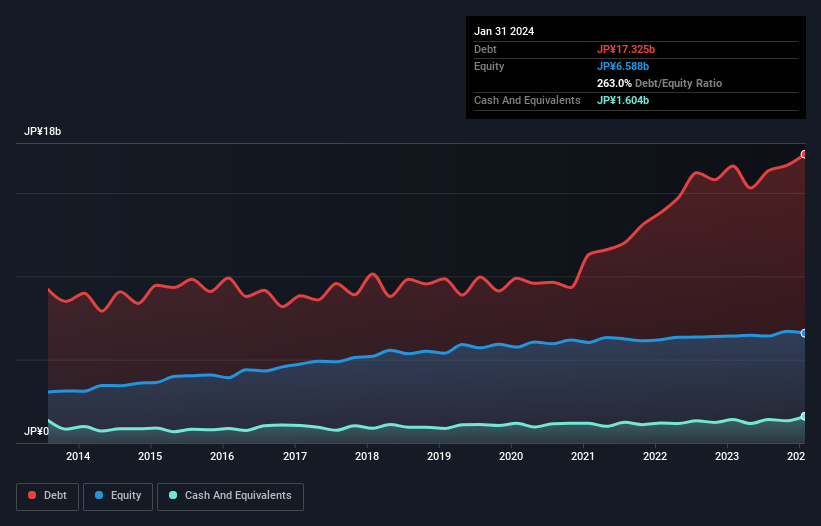Howard Marks put it nicely when he said that, rather than worrying about share price volatility, 'The possibility of permanent loss is the risk I worry about... and every practical investor I know worries about.' So it seems the smart money knows that debt - which is usually involved in bankruptcies - is a very important factor, when you assess how risky a company is. We note that Nitto Seimo Co., Ltd. (TSE:3524) does have debt on its balance sheet. But is this debt a concern to shareholders?
When Is Debt A Problem?
Debt and other liabilities become risky for a business when it cannot easily fulfill those obligations, either with free cash flow or by raising capital at an attractive price. In the worst case scenario, a company can go bankrupt if it cannot pay its creditors. However, a more frequent (but still costly) occurrence is where a company must issue shares at bargain-basement prices, permanently diluting shareholders, just to shore up its balance sheet. Of course, plenty of companies use debt to fund growth, without any negative consequences. When we think about a company's use of debt, we first look at cash and debt together.
View our latest analysis for Nitto Seimo
How Much Debt Does Nitto Seimo Carry?
You can click the graphic below for the historical numbers, but it shows that as of January 2024 Nitto Seimo had JP¥17.3b of debt, an increase on JP¥16.6b, over one year. However, it does have JP¥1.60b in cash offsetting this, leading to net debt of about JP¥15.7b.

A Look At Nitto Seimo's Liabilities
Zooming in on the latest balance sheet data, we can see that Nitto Seimo had liabilities of JP¥15.2b due within 12 months and liabilities of JP¥8.12b due beyond that. Offsetting these obligations, it had cash of JP¥1.60b as well as receivables valued at JP¥6.10b due within 12 months. So its liabilities total JP¥15.6b more than the combination of its cash and short-term receivables.
The deficiency here weighs heavily on the JP¥4.20b company itself, as if a child were struggling under the weight of an enormous back-pack full of books, his sports gear, and a trumpet. So we'd watch its balance sheet closely, without a doubt. After all, Nitto Seimo would likely require a major re-capitalisation if it had to pay its creditors today.
We measure a company's debt load relative to its earnings power by looking at its net debt divided by its earnings before interest, tax, depreciation, and amortization (EBITDA) and by calculating how easily its earnings before interest and tax (EBIT) cover its interest expense (interest cover). Thus we consider debt relative to earnings both with and without depreciation and amortization expenses.
While Nitto Seimo's debt to EBITDA ratio of 9.5 suggests a heavy debt load, its interest coverage of 7.6 implies it services that debt with ease. Overall we'd say it seems likely the company is carrying a fairly heavy swag of debt. Notably, Nitto Seimo's EBIT launched higher than Elon Musk, gaining a whopping 314% on last year. The balance sheet is clearly the area to focus on when you are analysing debt. But you can't view debt in total isolation; since Nitto Seimo will need earnings to service that debt. So if you're keen to discover more about its earnings, it might be worth checking out this graph of its long term earnings trend.
Finally, a business needs free cash flow to pay off debt; accounting profits just don't cut it. So it's worth checking how much of that EBIT is backed by free cash flow. During the last three years, Nitto Seimo burned a lot of cash. While that may be a result of expenditure for growth, it does make the debt far more risky.
Our View
On the face of it, Nitto Seimo's conversion of EBIT to free cash flow left us tentative about the stock, and its level of total liabilities was no more enticing than the one empty restaurant on the busiest night of the year. But at least it's pretty decent at growing its EBIT; that's encouraging. Overall, it seems to us that Nitto Seimo's balance sheet is really quite a risk to the business. So we're almost as wary of this stock as a hungry kitten is about falling into its owner's fish pond: once bitten, twice shy, as they say. When analysing debt levels, the balance sheet is the obvious place to start. But ultimately, every company can contain risks that exist outside of the balance sheet. We've identified 7 warning signs with Nitto Seimo (at least 2 which are potentially serious) , and understanding them should be part of your investment process.
Of course, if you're the type of investor who prefers buying stocks without the burden of debt, then don't hesitate to discover our exclusive list of net cash growth stocks, today.
Valuation is complex, but we're here to simplify it.
Discover if Nitto Seimo might be undervalued or overvalued with our detailed analysis, featuring fair value estimates, potential risks, dividends, insider trades, and its financial condition.
Access Free AnalysisHave feedback on this article? Concerned about the content? Get in touch with us directly. Alternatively, email editorial-team (at) simplywallst.com.
This article by Simply Wall St is general in nature. We provide commentary based on historical data and analyst forecasts only using an unbiased methodology and our articles are not intended to be financial advice. It does not constitute a recommendation to buy or sell any stock, and does not take account of your objectives, or your financial situation. We aim to bring you long-term focused analysis driven by fundamental data. Note that our analysis may not factor in the latest price-sensitive company announcements or qualitative material. Simply Wall St has no position in any stocks mentioned.
About TSE:3524
Nitto Seimo
Engages in the manufacture and sale of knotless nets for fishery and onshore uses in Japan.
Established dividend payer with mediocre balance sheet.
Market Insights
Community Narratives




